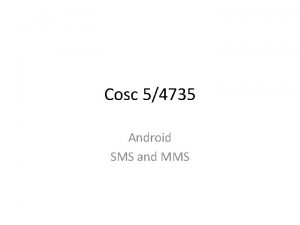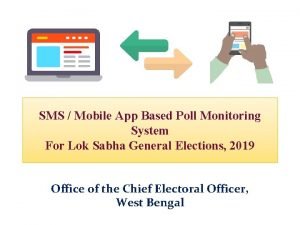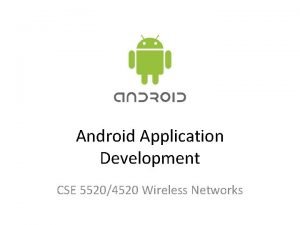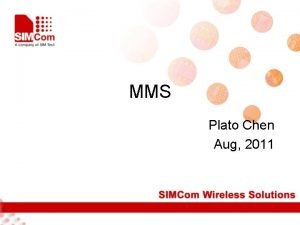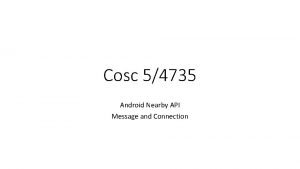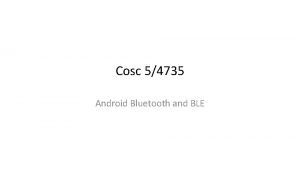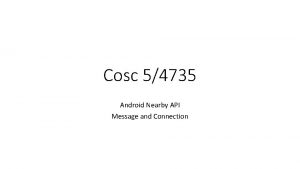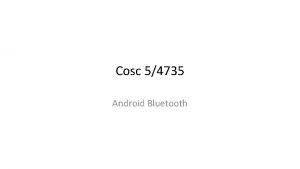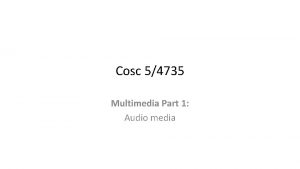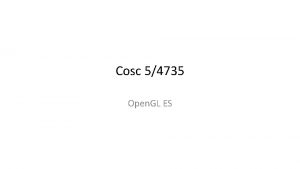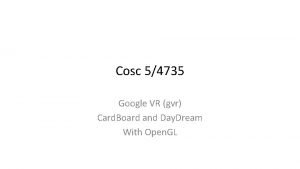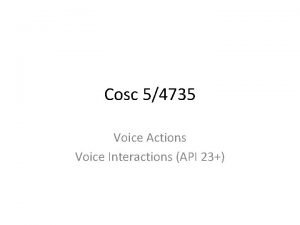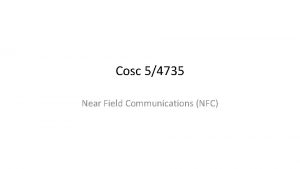Cosc 54735 Android SMS and MMS Introduction Wireless

































- Slides: 33

Cosc 5/4735 Android SMS and MMS

Introduction • Wireless messaging protocols predate – Java. ME, Android, Blackberry – IP over cellular networks (most cell phone networks) • Developed for Pagers and now used for call control. • Wireless Messaging services – Major: SMS, Cell Broadcast (SMS-CB), MMS

SMS • Short message service (ie texting) – Developed in 1985 by Global System for mobile (GSM) • All major terrestrial cellular network support it in some form. – 160 characters compressed into 140 bytes • There is a binary format as well (not MMS) – routed by SMS center (SMSC) • No guarantee of delivery. – Can be address to a port (on a device), so different applications can receive the sms message. • CDMA (most north American carriers) may not use port numbers

MMS • Multimedia Messaging Service – Works on top of a number of wireless protocols • SMS or TCP/IP – Uses same ideas as email • message subject, body, multiple messages parts • multiple receipts as well. – Uses MMS Center to route messages. – Problems, not everyone device supports it • Carriers can't agree on MMS, so may not route between Cell Carriers either.

mms message

SMB-CB • Short Message Service Cell Broadcast – Very new, not generally available. • May never be available to general public. • it's a point to area (1 to many) protocol – Allows you send a message to an area (such a geographic region or city) • Weather service, alerts, that sort of thing. (advertizing? ) • message is 82 bytes, text or binary – can be concatenated a mechanism to deliver longer messages.

As a side note. • Standard SMS message accept a port number as well as a phone number. – The default is port Zero. – But on other devices you can use your own port number as well, so it would stay off the main sms applications. • Ie a private sms message between applications. The user would never see the messages! – Android does not appear to support numbers in their sms API. • But port numbers are supported in the binary method.

SMS and Kit. Kat • Android 4. 4+ – There is a default SMS app now, which can be a third party app. • And only the default SMS app can write directory to the SMS Content. Provider – The other apps will fail silently. – The other apps can send a sms via an intent, which is shown in this lecture. • Any app can still read sms – But can not delete or “alter the flow” of the sms message.

• Well cover sending a sms message first • Then broadcast receiver, so we can receive sms messages. • We’ll come back to binary sms methods as well.

A note first • Depending on the API level, an import changes because of a deprecated • API 3 uses – import android. telephony. gsm. Sms. Manager; • While above, use – import android. telephony. Sms. Manager; • The change doesn't effect the code, just if the phone supports both GSM and CDMA. – The source code provided, has the gsm line commented out.

emulators • To send/receive sms message between 2 emulators, the "phone number" is the port number of the emulator. (normally 5554 for the first one, 5556 for the second) – remember you need to get the application on both emulators too. – You can also send to the emulator you on by using it’s number, so you don’t need two. – Test with the messaging app, before you test your code to make sure everything is working. • Or use ddms to send sms messages.

Sending a Text message • We get the static method of an Sms. Manager with get. Default() • We then send the SMS message with Pending. Intent – Pending. Intenet object is used to identify a target to invoke at a later time. – Can be used to display another activity after we send the message, but in our case, we just point to the same activity.

Sending a Text message (2) private void send. SMS(String phone. Number, String message) { Pending. Intent pi = Pending. Intent. get. Activity(this, 0, new Intent(this, sms. Demo. class), 0); Sms. Manager sms = Sms. Manager. get. Default(); sms. send. Text. Message(phone. Number, null, message, pi, null); } • Where phone. Number has the phone number to send to and message is the sms message.

Sending a Text message (3) • If we need to monitor the status of the SMS message sending process • Was there a failure or did the message actually go out. – you can actually use two Pending. Intent objects together with two Broadcast. Receiver objects – See the Android sms. Demo code example.

Receiving sms texts • We extend a broadcast receiver public class Sms. Receiver extends Broadcast. Receiver { @Override public void on. Receive(Context context, Intent intent) { } } • Intent Tells you what it is, via the get. Action() method. • The SMS message is contained and attached to the Intent object via a Bundle object. – The messages are stored in an Object array in the PDU format. – To extract each message, you use the static create. From. Pdu() method from the Sms. Message class.

Receiving an sms message • To receiving incoming SMS messages use a Broadcast. Receiver object. – For the code example, I use the receiver tag in the Android. Manifest. xml file. private static final String ACTION = "android. provider. Telephony. SMS_RECEIVED" ; public void on. Receive(Context context, Intent intent) { if(intent. get. Action(). equals(ACTION)){ //---get the SMS message passed in-}

Sms. Message • First get the SMS message from the bundle Bundle bundle = intent. get. Extras(); Object[] pdus = (Object[]) bundle. get("pdus"); Sms. Message[] msgs = new Sms. Message[pdus. length]; • now pull the message(s) out. for (int i=0; i<msgs. length; i++){ msgs[i] = Sms. Message. create. From. Pdu((byte[])pdus[i]); } • msgs[i]. get. Message. Body(). to. String() returns the message • msgs[i]. get. Originating. Address() has the from address

Android. Manifest. xml • We need permissions to send and receive sms message with our app's. <uses-permission android: name="android. permission. SEND_SMS"/> <uses-permission android: name="android. permission. RECEIVE_SMS"/> • To setup a receiver for the sms, will also need a tell the OS to send sms messages to the app. <receiver android: name=". SMSRecv"> <intent-filter> <action android: name="android. provider. Telephony. SMS_RECEIVED"/> </intent-filter> </receiver> • Where SMSRecv is our class this is to receive the sms and this is a static method so once installed, it will receive all sms messages.

Android. Manifest. xml (2) <manifest package=“edu. cosc 4730. smsdemo" … > <uses-permission android: name="android. permission. SEND_SMS"/> <uses-permission android: name="android. permission. RECEIVE_SMS"/> <application … > <activity android: name=". sms. Demo" … > <intent-filter> <action android: name="android. intent. action. MAIN" /> <category android: name="android. intent. category. LAUNCHER" /> </intent-filter> </activity> <receiver android: name=". SMSRecv"> <intent-filter> <action android: name="android. provider. Telephony. SMS_RECEIVED"/> </intent-filter> </receiver> </application> </manifest>

Max length • Text message can be 160 characters. If it’s longer then… • There is a function named divide. Message(string), which will break a message longer then 160 into parts, then you can send it with send. Multipart. Text. Message like this: Array. List<String> messagelist = sms. divide. Message(message); sms. send. Multipart. Text. Message(phonenumber, null, messagelist, null);

SMS folders • The sms folders are dealt with via contentproviders provided. – First you need use-permissions: • android. permission. READ_SMS – Short listing • • • All: content: //sms/all Inbox: content: //sms/inbox Sent: content: //sms/sent Draft: content: //sms/draft Outbox: content: //sms/outbox Failed: content: //sms/failed Queued: content: //sms/queued Undelivered: content: //sms/undelivered Conversations: content: //sms/conversations – Since MMS and SMS are combined in android • content: //mms-sms/conversations – See Chapter 9 of Android Pro book for more info.

Binary and port numbers • We can use send. Data. Message, • send. Data. Message (String destination. Address, String sc. Address, short destination. Port, byte[] data, Pending. Intent sent. Intent, Pending. Intent delivery. Intent) – sc. Address is the service center address or null to use the current default SMSC. – So we can send. Data. Message(phonenumber, null, (short) Port. Number, data, null) • Where data is a byte[] array.

Binary and port numbers (2) • Example: int MAX_SMS_MESSAGE_LENGTH = 160; int SMS_PORT = 8091; Sms. Manager manager = Sms. Manager. get. Default(); byte[] data = new byte[message. length()]; for(int index=0; index<message. length() && index < MAX_SMS_MESSAGE_LENGTH; ++index){ data[index] = (byte)message. char. At(index); } manager. send. Data. Message(phonenumber, null, (short) SMS_PORT, data, null);

Receiving binary • The receiver is just the same, except that you need to convert binary to data. Sms. Message[] msgs = new Sms. Message[ pdus. length]; msgs[i] = Sms. Message. create. From. Pdu((byte[]) pdus[i]); byte[] data = msgs[i]. get. User. Data(); for(int index=0; index<data. length; ++index) { info += Character. to. String((char)data[index]); }

Receiving binary (2) • The difference is in the manifest <receiver android: name=". Binary. SMSReceiver"> <intent-filter> <action android: name="android. intent. action. DATA_SMS_RECEIVED"/> <data android: port="8091"/> <data android: scheme="sms"/> </intent-filter> </receiver>

Lastly: Binary, port number • In testing, there were problems. – Some it just didn’t work. Don’t know why. • The binary receiver didn’t always get the message, only the messeger app got it, which displayed the “binary data”. – The emulators sort of worked, but you really need to phones to test with.

Android MMS 4. 3 and below • It’s possible with hidden APIs – But there is ZERO documentation on android's development site (at least using their search), code on the web, nor in any android book I have either. – We can do this using an intent though, which is the next slide. • The user will have to hit the send button in the messager app. These maybe help, but no complete answer: http: //stackoverflow. com/questions/6798730/android-mms-example http: //stackoverflow. com/questions/1914456/android-sdk-mms http: //stackoverflow. com/questions/6659957/mms-listener-for-android

Intent and MMS android 4. 3 and below. • We create an intent that launches the messaging app with the information and the attached “picture”. – Intent send. Intent = new Intent(Intent. ACTION_SEND); – send. Intent. put. Extra("address", Phone. Number); – send. Intent. put. Extra("sms_body", "some text"); • Note, find your own picture on the system and replace this one. – String url = "file: ///sdcard/Download/nasapic. jpg"; – send. Intent. put. Extra(Intent. EXTRA_STREAM, Uri. parse(url)); – send. Intent. set. Type("image/jpg"); – start. Activity(send. Intent);

MMS 4. 4+ • Dev. Bytes: Android 4. 4 SMS APIs – http: //www. youtube. com/watch? v=mdq 0 R 2 WQss. Q • http: //www. shinobicontrols. com/blog/posts/201 4/03/11/bitesize-android-kitkat-week-4 -replacing -the-default-sms-app • http: //stackoverflow. com/questions/21748209/r eceive-mms-messages-in-android-kitkat • http: //androiddevelopers. blogspot. com/2013/10/getting-yoursms-apps-ready-for-kitkat. html

Reading mms messages. • Ones that already on the device. – Use content: //mms-sms/conversations – http: //stackoverflow. com/questions/3012287/ho w-to-read-mms-data-in-android • For the varying “boxes” of mms – https: //developer. android. com/reference/android /provider/Telephony. Mms. html

Example code • Sms. Demo is a simple sms send/receive – Remember you need two phones or one phone and the ddms to test with • sms. Demo 2 uses binary data and port numbers • mms. Demo shows how to use an intent to “send” a picture. – It’s a hack and should not be used.

References • http: //mobiforge. mobi/developing/story/smsmessaging-android • http: //blog. bruary. net/2009/06/android-smshandling. html • http: //stackoverflow. com/questions/990558/and roid-broadcast-receiver-for-sent-sms-messages • http: //developer. android. com/intl/zh. CN/reference/android/telephony/Sms. Manager. h tml • http: //stackoverflow. com/questions/2726976/ho w-to-receive-text-sms-to-specific-port

Q&A
 Proximus mms
Proximus mms Forum.unity.com/threads/game-over.54735
Forum.unity.com/threads/game-over.54735 Forum.unity.com/threads/game-over.54735
Forum.unity.com/threads/game-over.54735 Multimedia message from 4735
Multimedia message from 4735 Poll monitoring system app
Poll monitoring system app C# bramka sms
C# bramka sms Telecommunications, the internet, and wireless technology
Telecommunications, the internet, and wireless technology Android wireless application development
Android wireless application development Teoria de colas formulas
Teoria de colas formulas Sistema mms
Sistema mms Cms measures management
Cms measures management Mms case study
Mms case study Mtps.mms
Mtps.mms Spedas
Spedas Mmsmms
Mmsmms Mms sdc
Mms sdc Viggo holmstedt
Viggo holmstedt Www.scsb.org mms
Www.scsb.org mms Morgan molten metal systems gmbh
Morgan molten metal systems gmbh Open bee download
Open bee download Dr martin dunne
Dr martin dunne India's it act
India's it act Cms measures management
Cms measures management Mms model
Mms model Mms st andrew
Mms st andrew Mms test
Mms test Mms procedure
Mms procedure Contoh deduksi
Contoh deduksi Mongodb yum
Mongodb yum Mms sign
Mms sign Cms mms blueprint
Cms mms blueprint Lecture mms
Lecture mms Mms cern
Mms cern Cms mms
Cms mms



